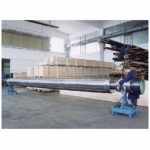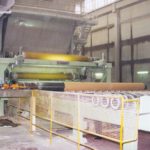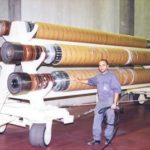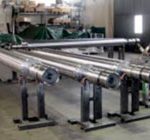It is a quick coupling used in shafted center wind and center unwind applications.
Safety Chucks do three things:
- They provide for quick change at the end of a production run (either winding or unwinding). A key benefit of the Safety Chuck is that it provides for less down time during turn around, making the operation more cost efficient.
- They provide a means of transmitting torque to the roll that is either winding or unwinding. Torque in the form of a drive on the rewind and torque in the form of a brake on the unwind stand.
- Safety Chucks also provide for concentricity between the centerline (axis) of the Safety Chuck and the centerline of the roll shaft. Less eccentricity between the roll shaft and the Safety Chuck means less vibration and wear.
The safety chuck was developed for the textile industry back in the 1940’s. It received its name by offering the safety feature of closing automatically when rotated away from the “12 O’Clock” open position.
Goldenrod/Svecom manufactures and maintains a huge inventory of many standard models and spare parts to handle your immediate needs. We also offer custom solutions for your most challenging applications. All chucks are manufactured to ISO 9002 quality standards and are fully inspected prior to shipment. Click on the product literature below to view the capacities. For price quotes, contact Customer Service or call the Goldenrod sales representative in your area.
Product Literature:
For direct service, click here to locate your area sales representative.
Some defects that can be addressed by winding products on a Differential Shaft include:
- Film caliper variation
- Coated products with inconsistent thickness
- Laminates with variation in substrate thickness
- Other situations where thickness varies across the web
Symptoms of the operating defects by winding products on a Differential Shaft
- Wound roll tightness variation between rolls wound on the same shaft
- Wound roll tightness variation between rolls would on a duplex machine
- Individual core crush or locking
- Individual slit web breaks
- Dished rolls
- Coated products with adhesive squeezed out from between layers
For direct service, click here to locate your area sales representative.
Why? They do this to by-pass the paper machine winder. By winding on cores directly at the paper machine and sending the jumbo rolls of tissue, towel or paper board directly to converting or out the door to customers, they eliminate an entire operation. Tissue machine re-winders cost a great deal of money. Not only do you have to maintain them, but you also have to staff them.
In today’s mill market, every nickel counts. Goldenrod manufacturers the industry standard when it comes to pneumatic, multi-bladder reel spools.
- A New Reel Spool
- New Reel Spool
- Reel Spool
- Reel
The Series 1260-LDB Pneumatic Reel Spool Shaft is the Tissue Industry standard. OEMs that supply machines to this market as well as the top five leading tissue manufacturers all use the Series 1260-LDB Reel Spool. What Makes Our Pneumatic Reel Spool Better Than The Rest?
- Maintenance
- No Down Time
- Increased Performance Fast Bladder replacement.
If you have a set of hex wrenches, scissors and a spare parts kit, it should take no more than a half hour for this procedure. It is a major ordeal to repair a leaf, lug, spiral or button shaft. Most often mills send out there shafts for repair. This is costly and time consuming. The ability to fix our shafts “in-house”, as opposed to sending them out for maintenance, puts money back in the your company’s pocket. Greater expansion on the diameter of the shaft. We can make our shaft O.D. smaller and still get a superior roll due to increased expansion.
This is significant for two reasons. First, it is “shaft puller” friendly (fewer mishaps with loading and unloading). Second, we don’t need to be concerned with “loping” or “bouncing” a problem associated with undersized single bladder shafts. Independent valves. If one or more bladders leak, the shaft continues to run. Every expander is independent of one another due to a proprietary internal valve system. The journals on our Reel Spools are bolt-on so getting to the internals is exceptionally easy. Core Centering: On today’s high speed paper machines it is critical to keep vibration and run-out to a minimum. We have the ability to center the core on the diameter of the shaft before gripping it. Metal centering expanders work in conjunction with rubber gripping expanders. The metal ledges are designed to come up first, center the core on the diameter of the shaft. Following that, the rubber expanders raise to grip the core. The Model 1260 LDB is the only shaft on the market that offers this feature.
Product Literature:
- Mill Duty Brochure (PDF)




